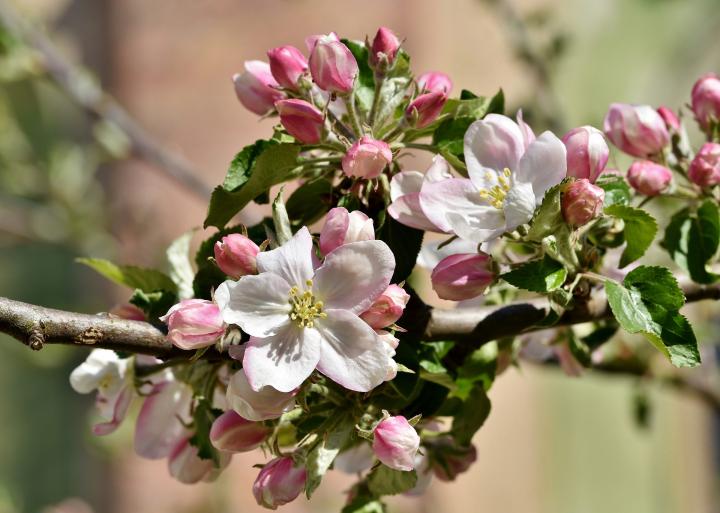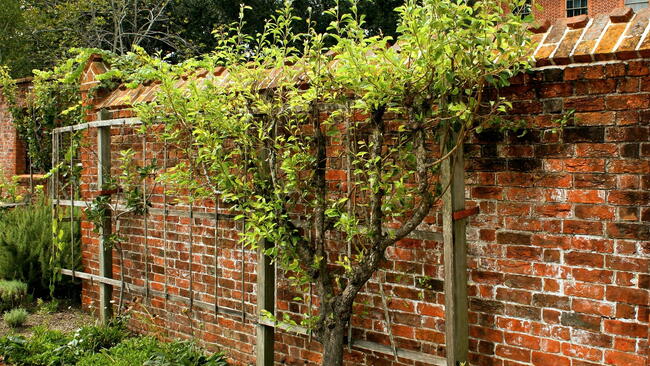
Planting, Growing, and Harvesting Apples
The Almanac Garden Planner - Use It Free for 7 Days!
Plan your 2025 garden with our award-winning Garden Planner.
Types
Choose the Right Varieties
- Look for disease-resistant trees, such as ‘Liberty’, ‘Jonafree’, ‘Macfree’, and ‘Williams Pride’, which will give you the ability to grow organic fruit or to use fewer chemicals. Maintenance is easier, too.
- You need to choose a rootstock. All apple trees sold have 2 parts: a “rootstock” or foundation and a “scion” or top portion, determining the fruit variety. A rootstock can be “seedling” or “standard” (which produces a full-size tree), or it can be “dwarfing” or “size-controlling” (which produces a smaller tree for easier care and harvest).
- For dwarf trees, make sure that the rootstock is specified. A Bud 9 is a common, hardy tree that’s easy to train for USDA Climate Zones 3 to 5. The M9 is probably the most widely planted rootstock, though it could die in frigid winters.
- Buy dormant, bare-root, 1-year-old nursery trees with good root systems. Dwarfs and semi-dwarfs will bear in 3 to 4 years, yielding 1 to 2 bushels per year. Standard-size trees will bear in 5 to 8 years, yielding 4 to 5 bushels of apples per year.
- The variety of apple selected should be based on fruit characteristics, bloom time, and pollen compatibility. Consult a local nursery to see which trees are potential cross-pollinators in your area. For best results, include a ‘Grimes Golden’, ‘Golden Delicious’, ‘Red Delicious’, or ‘Winter Banana’ in your planting. These varieties are known pollinators. Crabapple trees can also be used as pollinators if they bloom simultaneously as the desired variety. Nursery catalogs will provide pollination charts.
- Most apple varieties do not pollinate themselves or any flowers of the same apple variety; this requires planting at least two different apple tree varieties close to one another so that the bees can pollinate. (There are actually some self-pollinating apple tree varieties if you are really short on space. However, even these apple trees will bear more fruit if cross-pollinated.)
Also, consider how you will use your apples: Do you love to bake apple pies? Or, perhaps you just want apples that taste far better than what you could buy in a grocery store. See Best Apples for Baking for more information.
- A young dwarf tree produces about 1 1/2 bushels of fruit—and even less when the tree is part of an apple hedge. So, if you’re interested in baking lots of ‘Cox’s Orange Pippin’ apple pies, you’ll need to plant several trees of that variety to get enough fruit.
- If you have no particular culinary goal, try planting one of each different variety that ripen over the entire harvest season. Then, you can enjoy regular apple tastings and still have enough fruit on hand for a “mess” of cooked apples.
- Seek out the advice of local orchardists about the varieties that will do well in your area. Do the bulk of your planning from an easy chair with a half-dozen nursery catalogs in your lap!
Cooking Notes
- You can freeze apples by stewing washed chunks with a dash of water until they soften. Once ready, sieve and pour the stewed apples into containers, leaving a small space at the top as they will expand slightly when frozen, and pop into the freezer.
- You can also cut your fruits into thin slices then dry them out in a dehydrator to make a deliciously chewy and healthy snack.
- Planning to bake or cook your apples into an apple pie or meal? See our chart on the best baking and cooking apples in North America.
“Baked apples have an excellent effect upon the whole physical system, feeding the brain as well as adding to the flesh, and keeping the blood pure; also preventing constipation and correcting a tendency to acidity, which produces rheumatism and neuralgia.” –The 1898 Old Farmer’s Almanac
ADVERTISEMENT
When is the right time to prune apple trees in central Michigan?
My apples tree got small black insect on the back of the leaves white cotton covered the stem all apples filled, What I have to use to help three
Remove them.
Correct link to the Hardiness Map https://planthardiness.ars.usda.gov
I have three apple trees, no blossom, no fruit for a few years now.
One tree if very old the others are three years. What can I do for them.
Young apple trees do not flower or produce fruit in the early stages of their lives. Dwarf and semi-dwarf varieties typically do not flower and bear fruit for 3 to 5 years, while standard size apple trees may not produce flowers/fruit for 5 to 10 years. It is important to follow a pruning regimen in late winter/early spring to avoid overcrowding. For pollination purposes, two cultivars are needed within 50 to 100 feet.
As for your older tree, it may take a few years of careful pruning to bring it back. You first want to remove a few larger branches to increase light and air flow, as well as any branches that are diseased or broken. Just remember not to prune too much to avoid the tree putting too much energy into growing new branches. And again, pruning in late winter/early spring is best.
Seems they produce about every other year. Has anyone else experienced this?
My wife and I live in Central California and are looking to plant apple trees in our backyard. The problem is, we don't have a lot of flat space to do so. Our backyard has a sloping hill that holds up a retaining wall and the flat space at the top of the hill is only about 2'-3' wide, which happens to be the width of the stainless steel tubs we've been looking at.
We bought a house in Long Beach, CA with an apple tree. The tree grows healthy and produces apples, but they have not been very firm and crispy, and tend to have brown inside of them. How can I tell what kind of tree I have and what I should do to improve the fruit?
Wish we could help but we don’t have enough information to figure this one out. Our best advice it to take pictures and bring them to a local nursery, one that carries fruit trees, if possible. Good luck with this!











